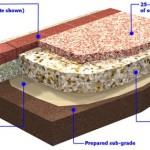What Is A Bedding Plane?
In geology, a bedding plane is a surface that separates two layers of sedimentary rock. It forms when sediment is deposited in layers and then compacted and cemented together. The bedding plane can be seen as a thin line or seam between the layers of rock. The bedding plane is important because it can provide information about the environment in which the rock was formed. For example, the thickness of the bedding planes can indicate the rate at which the sediment was deposited. The presence of ripple marks or other sedimentary structures on the bedding plane can indicate the direction of the water flow that deposited the sediment. The bedding plane can also provide information about the age of the rock. For example, if the bedding plane contains fossils, the fossils can be used to date the rock.
The bedding plane is a common feature in sedimentary rocks. It can be seen in a variety of rock types, including sandstone, shale, and limestone. The bedding plane is important because it can provide information about the environment in which the rock was formed, the age of the rock, and the history of the area where the rock is found.
How Bedding Planes Form
Bedding planes form when sediment is deposited in layers. The sediment can be deposited by a variety of processes, including water, wind, and ice. As the sediment is deposited, it is compacted by the weight of the overlying sediment. This compaction causes the sediment to become denser and harder. Over time, the sediment is cemented together by minerals that are dissolved in water. This cementation process creates a solid rock. The bedding plane is the surface that separates the layers of sediment that have been compacted and cemented together.
Types of Bedding Planes
There are a variety of different types of bedding planes. The most common type of bedding plane is the planar bedding plane. A planar bedding plane is a flat surface that separates two layers of rock. Other types of bedding planes include cross-bedding planes, ripple marks, and mud cracks. Cross-bedding planes are formed when sediment is deposited by a current that is flowing in a different direction than the main flow of water. Ripple marks are formed when sediment is deposited by a wave or current that is moving in a regular pattern. Mud cracks are formed when mud dries out and cracks.
Importance of Bedding Planes
Bedding planes are important because they can provide information about the environment in which the rock was formed, the age of the rock, and the history of the area where the rock is found. Bedding planes can also be used to identify different types of rock and to determine the sequence in which the rocks were deposited. This information can be used by geologists to reconstruct the geologic history of an area.
Field Photography Of Travertine Showing Two Joint Sets And Bedding Scientific Diagram

Bedding Plane An Overview Sciencedirect Topics

Bedding Plane View Of The Siderite Horizon Between Devonian And Scientific Diagram

Rocks 3 What Are Joints And Bedding Planes Is Rock Permeability Teleskola

Sepm Strata

Bedding And Lamination Geology Is The Way
Rocks 3 What Are Joints And Bedding Planes Is Rock Permeability Teleskola

Energy And Geology A Level Geography Edexcel Revision Study Rocket

Sliding Failure Of The Se Slope Occurred Along A Bedding Plane When Scientific Diagram

Bedding Plane An Overview Sciencedirect Topics








